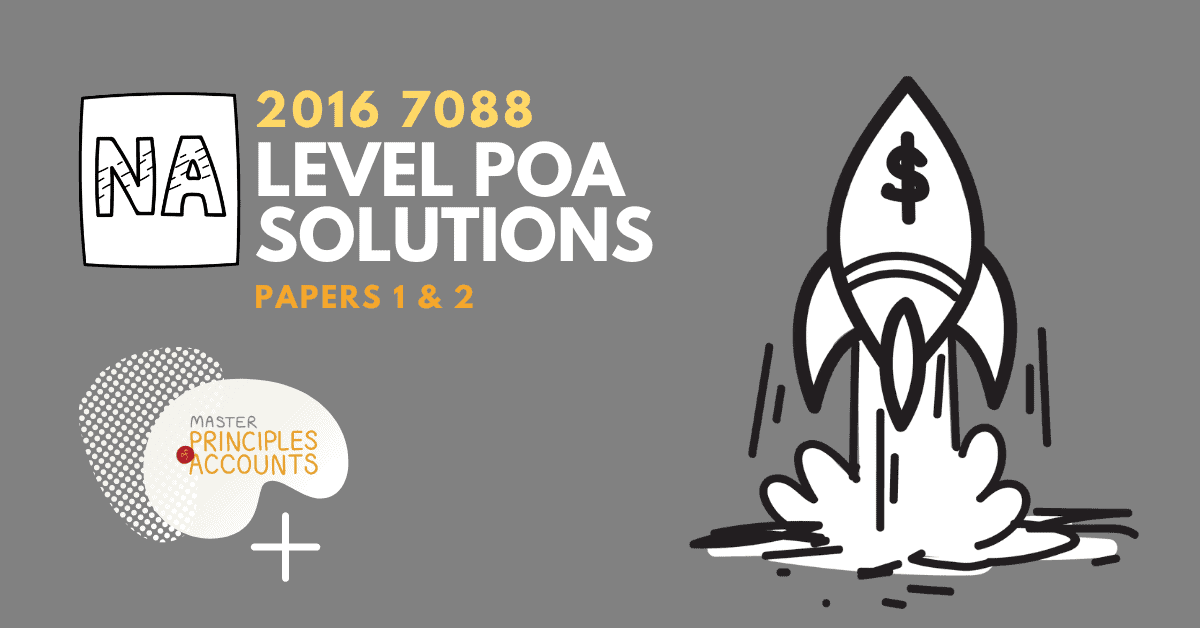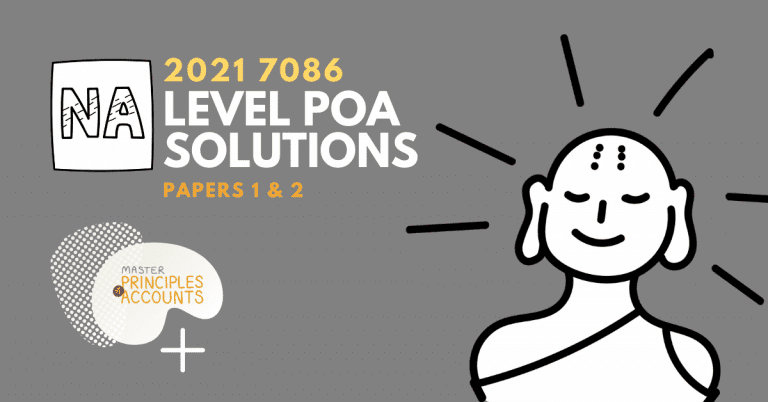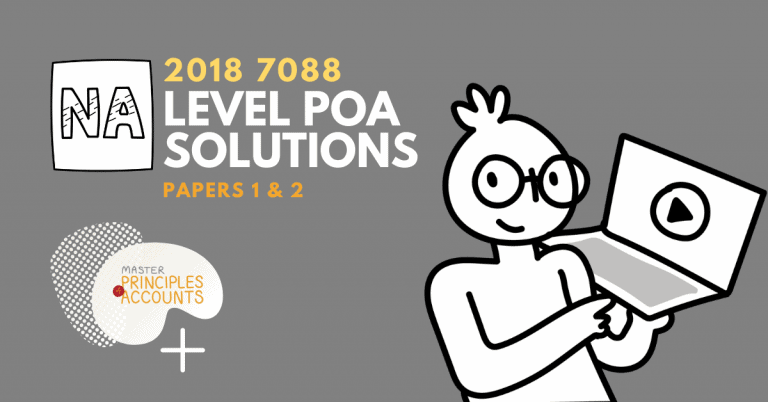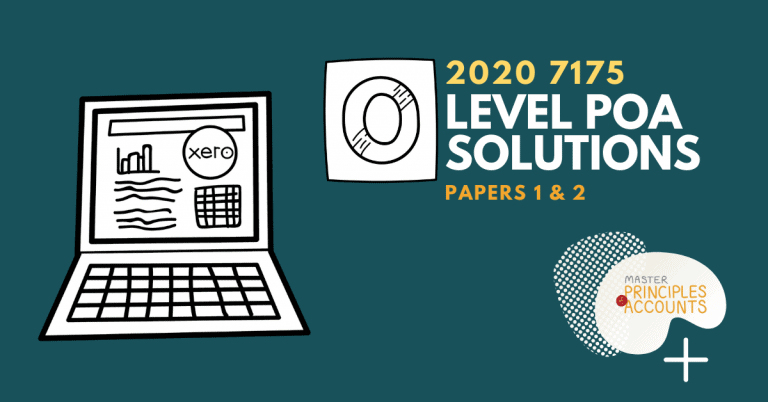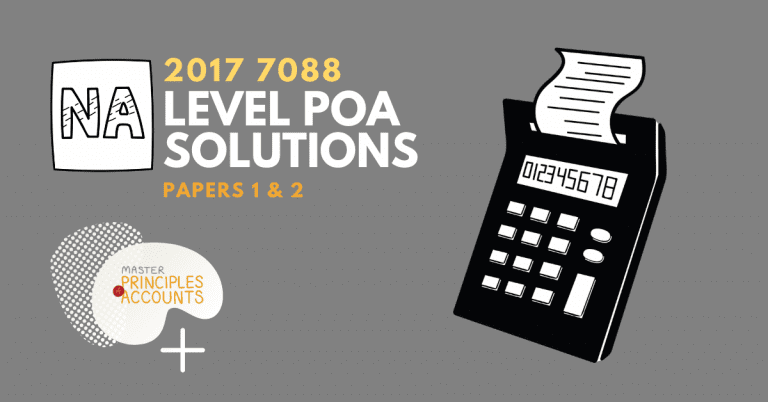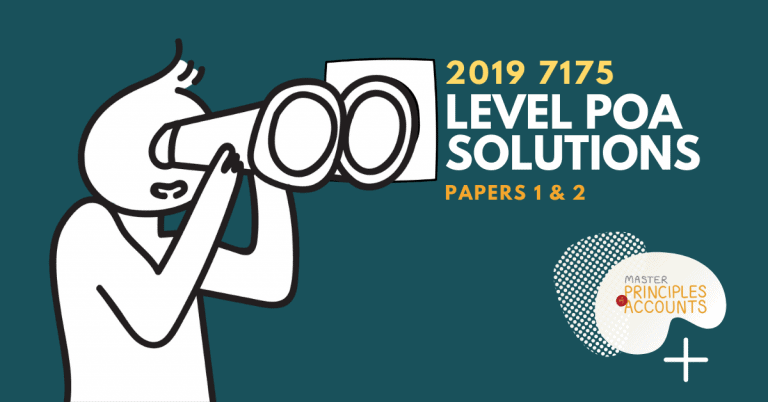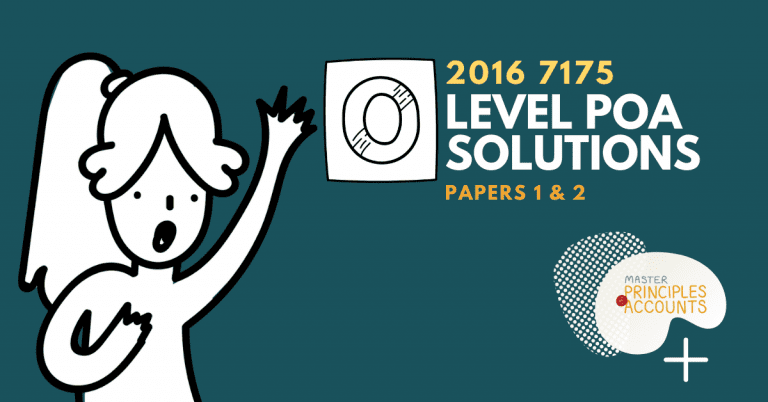2016 N Level POA Answers
Phew! It’s over.
On Paper 1 day last Friday, we tackled multiple topics + theory just the night before exams. Here’s the result:

The Suggested Solutions
Here’s the draft/suggested/imperfect solutions for Paper 1 and 2.
Paper 1:
ai)
- Business deposits cash into the bank account within a year to reduce the bank overdraft.
- Shown as current liabilities in the statement of financial position.
aii)
- Business makes regular cash payments in equal instalments over the loan period or pay one lump sum payment at the end of the loan period.
- Shown as a non-current liability as long term borrowing in the statement of financial position.
b)
| Items | Increase | Decrease | No effect | |
| i) | Non-current assets | ✓ | ||
| ii) | Cash at bank overdrawn (bank overdraft) | ✓ | ||
| iii) | Long-term loan account | ✓ | ||
| iv) | Owner’s capital | ✓ | ||
| v) | Profit for the year | ✓ | ||
| vi) | Working capital | ✓ |
a)
Trade payables control account
| Date | Particulars | Dr ($)+ | Cr ($)- | Balance |
| 2015 | ||||
| Jan 1 | Balance b/d | 16 260 Cr | ||
| Dec 31 | Inventory | 41 130 | 57 390 Cr | |
| 31 | Inventory (cash) | 460 | 56 930 Cr | |
| 31 | Cash at bank | 32 940 | 23 990 Cr | |
| 31 | Inventory (returns) | 8 630 | 15 360 Cr | |
| 31 | Trade receivable control | 120 | 15 240 Cr | |
| 2016 | ||||
| Jan 1 | Balance b/d | 15 240 Cr |
b) Invoice
c) Historical cost concept
a)
Journal
| Date | Particulars | Dr ($) | Cr ($) |
| 2015 | |||
| April 1 | Motor vehicles | 7 300 | |
| Other payable – Exe Motors | 7 300 | ||
| Being bought a motor vehicle from Exe Motors on credit at $7 300 |
bi) Capital expenditure are funds used by a company to acquire, upgrade, and maintain physical assets such as property, plants, buildings, technology, or equipment.
ii) Revenue expenditures are short-term expenses used in the current period or typically within one year.
c)
| Capital Expenditure | Revenue Expenditure | |
| Diesel for the motor van | ✓ | |
| Painting business name on the motor van | ✓ | |
| Motor van service | ✓ | |
| Motor van insurance | ✓ |
a) Wu account
| Date | Particulars | Dr ($)+ | Cr ($)- | Balance |
| 2016 | ||||
| Aug 1 | Balance b/d | 2 108 Dr | ||
| 2 | Sales revenue | 5 762 | 7 870 Dr | |
| 14 | Sales returns | 1 584 | 6 286 Dr | |
| 31 | Cash at bank | 4 500 | 1 786 Dr | |
| Sep 1 | Balance b/d | 1 786 Dr |
bi) Journal
| Date | Particulars | Dr ($) | Cr ($) |
| 2016 | |||
| Sep 5 | Trade receivable – Wu | 4 500 | |
| Cash at bank | 4 500 |
ii) 1. Post-dated cheque
2. Incomplete cheque
ci) Cash discount is to encourage prompt payment.
ii) Discount allowed
Paper 2:
Tung
Statement of Financial Performance for the year ended 30 April 2018
| $ | $ | |
| Sales revenue | 357 500 | |
| Less: Sales returns | 11 700 | |
| Net sales revenue | 345 800 | |
| Less: Cost of sales | 232 800 | |
| Gross Profit | 113 000 | |
| Add: Other income | ||
| Discount received | 4 500 | |
| 117 500 | ||
| Less: Other Expenses | ||
| Insurance expense (3 000 – 500) | 2 500 | |
| Motor vehicle expense (600 – 395) | 205 | |
| General expense (20 795 + 192) | 20 987 | |
| Wages and salaries | 30 200 | |
| Depreciation on fixtures and fittings (10% x 5 000) | 500 | |
| Depreciation on motor vehicle (25% x (10 000 – 2 500) | 1 875 | 56 267 |
| Profit for the year | 61 233 |
Tung
Statement of Financial Position as at 30 April 2018
| Cost | Accumulated Depreciation | Net Book Value | |
| Assets | $ | $ | $ |
| Non-current assets | |||
| Fixtures and fittings (1 000 + 500) | 5 000 | 1 500 | 3 500 |
| Motor vehicles (2 500 + 1 875) | 10 000 | 4 375 | 5 625 |
| Total non-current assets | 9 125 | ||
| Current assets | |||
| Trade receivables | 39 000 | ||
| Less: Allowance for impairment of trade receivables | 2 000 | 37 000 | |
| Inventory | 17 500 | ||
| Cash at bank | 23 650 | ||
| Prepaid insurance expense | 500 | ||
| Total current assets | 78 650 | ||
| Total assets | 87 775 | ||
| Equity and Liabilities | |||
| Capital (35 245 + 61 233 – (37 500+395)) | 58 583 | ||
| Current liabilities | |||
| Trade payables | 29 000 | ||
| General expense payable | 192 | ||
| Total current liabilities | 29 192 | ||
| Total equity and liabilities | 87 775 |
a) Allowance for impairment of trade receivables account
| Date | Particulars | Dr ($)+ | Cr ($)- | Balance |
| 2015 | ||||
| Aug 31 | Impairment loss on trade receivables (2 500 + 1 320) | 3 820 | 3 820 Cr | |
| Sep 1 | Balance b/d | 3 820 Cr | ||
| 2016 | ||||
| Aug 31 | Impairment loss on trade receivables (4 000 – 3 820) | 180 | 4 000 Cr | |
| Sep 1 | Balance b/d | 4 000 Cr |
b) Impairment of trade receivables account
| Date | Particulars | Dr ($)+ | Cr ($)- | Balance |
| 2015 | ||||
| Aug 31 | Allowance for impairment of trade receivables(2 500 + 1 320) | 3 820 | 3 820 Dr | |
| 31 | Income summary | 3 820 | – | |
| 2016 | ||||
| Aug 31 | Allowance for impairment of trade receivables | 180 | 180 Dr | |
| 31 | Income summary | 180 | – |
c) Prudence concept
a) Cash at bank account (adjusted)
| Date | Particulars | Dr ($)+ | Cr ($)- | Balance |
| 2016 | ||||
| Jun 30 | Balance b/d | 993 Dr | ||
| 30 | Bank charges | 72 | 921 Dr | |
| Jul 1 | Balance b/d | 921 Dr |
b) Bank reconciliation statement as at 30 June 2016
| $ | $ | |
| Credit balance as per bank statement | 988 | |
| Add: Deposit in transit | ||
| Trade receivables – F Short | 257 | |
| Less: Cheque not yet presented | ||
| Trade payables – S Lee | 324 | |
| Credit balance as per adjusted cash at bank account | 921 |
c) Current assets
d)1. To reconcile the differences between the cash at bank balance and the bank statement balance at the end of every month
2. To determine what should be the business’ actual balance in the Cash Book
3. To deter fraud
4. To correct any errors in the cash book made by the business
a )Journal
| Date | Particulars | Dr ($) | Cr ($) |
| 2016 | |||
| Sep 30 | Fixtures and fittings | 5 000 | |
| Capital | 5 000 | ||
| 30 | Rent expense | 350 | |
| Capital | 350 | ||
| 30 | Depreciation on fixtures and fittings | 750 | |
| Accumulated Depreciation on fixtures and fittings | 750 |
b) Correction of errors and drawings of goods for personal use.;
c) It is the brief explanation that provides the details of journal entry and helps understand the account debited or credited.
d) Accounting entity concept
e) Banks, government, competitor, investors
a) General expenses account
| Date | Particulars | Dr ($)+ | Cr ($)- | Balance |
| 2015 | ||||
| Jul 1 | General expense payable | 220 | 220 Cr | |
| 2016 | ||||
| Jun 30 | Cash at bank | 5 250 | 5 470 Dr | |
| 30 | General expense payable | 175 | 5 645 Dr | |
| 30 | Income summary | 5 645 | – |
bi) Expenses for services that have been paid for but not been used yet.
ii) Income for services which have not been provided yet but have been paid for already.
c) Integrity and objectivity
Feel free to comment or reply with your feedback and suggestions!

